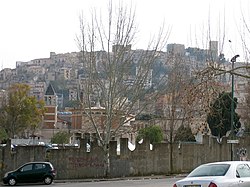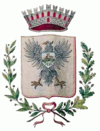Salemi
| Salemi, Sicily | ||
|---|---|---|
| Comune | ||
 |
||
|
||
| Location of Salemi, Sicily in Italy | ||
| Coordinates: 37°49′N 12°48′E / 37.817°N 12.800°E | ||
| Country | Italy | |
| Region |
|
|
| Province / Metropolitan city | Trapani (TP) | |
| Frazioni | Sinagia, Filci, Gorgazzo, San Ciro Fontana Bianca, San Ciro Petrazzi, Ulmi | |
| Area | ||
| • Total | 181 km2 (70 sq mi) | |
| Elevation | 446 m (1,463 ft) | |
| Population (2007) | ||
| • Total | 11,254 | |
| Demonym(s) | Salemitani | |
| Time zone | CET (UTC+1) | |
| • Summer (DST) | CEST (UTC+2) | |
| Postal code | 91018 | |
| Dialing code | 0924 | |
| Patron saint | St. Nicholas | |
| Saint day | December 6 | |
| Website | Official website | |
Salemi is a town and comune in South-Western Sicily, Italy, administratively part of the province of Trapani. It is located in the Belice Valley.
Salemi is where Giuseppe Garibaldi announced the annexation of Sicily on May 14, 1860, as part of the Expedition of the Thousand, briefly making the town his headquarters after his landing at Marsala two days earlier.
Located on the slopes of Monte delle Rose Mazzaro between the river and the river Grande, the town is situated on the site of the ancient city Elima of Halyciae. Theatre of the continuous wars between Selinunte and Segesta, Salemi (or rather: Alicia as it was known in these times), probably due to their common origin, has always been allied with Segesta.
In 272 BC, Salemi (then known as Alicia) was conquered by the Romans and declared a free city and free from taxes for its voluntary submission.
In the fifth century, as the rest of Sicily, Salemi fell under the dominion of the Vandals, and then under that of the Goths.
In 535, it was submitted by the Byzantine Belisarius, the general of Justinian.
In 827, Salemi fell under the control of the Arabs, and the area prospered. It was during this time that the name Salemi seems to have originated. In this regard, there are several theories about the origin of the name: one theory is attributed in honor of "Saleiman", son of the commander who conquered Alicia, that resulting from "rooms" for the presence of the Salty river which makes the brackish waters that run through the city; another theory is that Salemi is derived from the meaning of "Salam" and that is a healthy and safe city, and "Salem", which means peace. The urban center was structured then, and remains in the same configuration today. In terms of agriculture, the Arabs introduced many new crops to Salemi and the surrounding areas: oranges, lemons, peaches, apricots, asparagus, artichokes, cotton, eggplant and spices such as saffron, cloves and cinnamon.
...
Wikipedia


